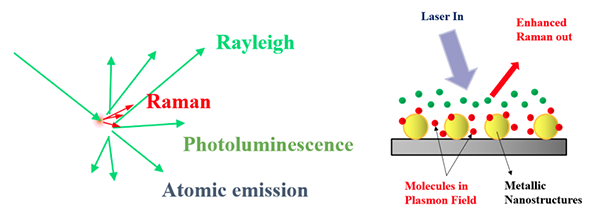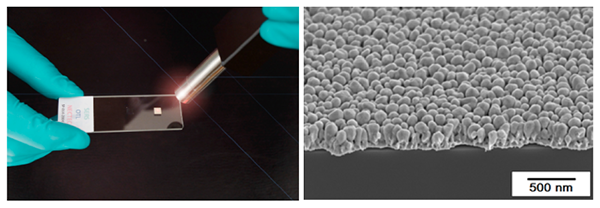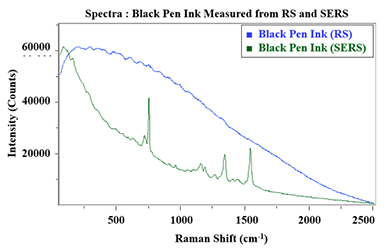Raman scattering is a phenomenon that describes a shift in frequencies between a light that is illuminating a material and a fraction of the scattered light from that material. The frequency shift is due to molecular vibrations of the material. Different materials exhibit different fashions of molecular vibrations and therefore produce Raman scattered light at distinctive frequencies. In other words, the amount of frequency shift is unique to each material. Therefore, Raman scattering allows us to identify and differentiate the materials under study from one another.
The effect of Raman scattering is typically weak, plus the presence of fluorescence can make Raman signals (spectra) difficult to detect. The problem has been overcome by the technique of Surface-Enhanced Raman Spectroscopy (SERS), which is the extension of the standard Raman Spectroscopy. The main difference between SERS and Raman Spectroscopy is the incorporation of metallic nanostructures or colloids, which results in the amplification of electromagnetic fields generated by the excitation of localized surface plasmons when the sample is illuminated by a light source. Hence, SERS allows for signal enhancements up to 10 orders of magnitude. [1] This improvement enables further spectra collections from samples that cannot be detected using the standard Raman Spectroscopy.

Surface Enhanced Raman Spectroscopy (SERS) is a promising tool with several great potentials that can aid procedures in the field of forensic investigation. The advantage of SERS is that it requires minimal amount of sample which is important since in many cases in criminal investigations, there is not always a large quantity of samples available. The process is also rapid and repeatable. Several applications of SERS in forensic science have already been studied. Firstly, questioned document examinations can benefit from the ability to identify various type of pen inks and printer inks (toners) on papers. [1] Its detection capability can extend to include paints on canvas or other fiber materials. [2] Another branch of application is the detection of explosives. [1,3] Moreover, illicit drugs and controlled substances can also be identified. [1] Many studies have also tried to use SERS to identify biological materials including DNA, blood, and body fluids such as saliva, urine and serum. [1,2]
The advancement of SERS depends on the fabrications of metallic-incorporated structures that will handle compounds of material under study. At NECTEC, researchers have successfully fabricated SERS chips, called OnSpec, which are silver nanorods on a silicon substrate, as shown in Figure 2. Silver or gold decorated on nano-patterned templates, is another technique that researchers at NECTEC have begun work on. The researchers have used their SERS chips to detect pen inks, explosive substances, illicit drug, pesticides and biomolecules including Zika virus, Dengue virus and tuberculosis. In the first installment of this article series, the detection of pen inks by various SERS techniques will be discussed in the following sections.

Pen ink detection by SERS
The study of pen ink detection by SERS at NECTEC began with collections of ink data by direct measurements of Raman Spectroscopy, as well as, by using the SERS chips to measure extractions of the inks on paper. Ink from 150 different pens consisting of water, oil or gel base, in red, black and blue color, was collected on paper. Three types of Raman spectrometers (Figure 3) were used, including the handheld Raman spectrometer, the portable Raman spectrometer, and the lab-grade Raman mapping systems (one at NECTEC, and the other at Central Institute of Forensic Science, Thailand). The initial results showed that the direct Raman measurement from any of these systems suffered from fluorescence interference and low signal to noise ratio. However, good results were obtained from our SERS chips, OnSpec, where fluorescence was suppressed and the Raman signal was highly enhanced, as exhibited in Figure 4.

Figure 3 : Raman spectrometers in use for the studies at NECTEC: (a) handheld Raman system, (b) portable Raman system, and (c) high-performance Raman microscope.

Figure 4 : Example of Raman spectra as measured from black pen ink by conventional Raman spectroscopy and SERS.
Furthermore, it was found that the measured spectra by OnSpec changed with time. This is a challenge as well as a benefit in that samples should be measured right away to prevent uncertainty from the Raman measurements. However, this time-dependent attribute will allow us to identify the age of the ink under investigation, which is beneficial and can help in the case of document forgery.
The current measurement technique using SERS chip still posts two major issues. The first one is that the current ink extraction method damages the document. This is because a solvent needs to be dropped onto the actual questioned document in order to dissolve and extract the ink and transfer it to a SERS chip for measurements. Ideally, there should be no damage on the questioned documents since most likely they are the only form of evidence available. So, eliminating the damages brought upon the questioned documents is the issue that needs fixing fast. The second issue is that SERS for questioned documents is a technique that needs developments in its discrimination power to be legally approved. Other approved methods, which currently are the most accurate, include thin-layer chromatography (TLC) and using experts in handwriting analysis (graphology) to detect forgery or counterfeit. So accuracy plus easy handling and non-damaging procedures, are aspects that SERS need to acquire in order to become the mainstream technique of ink detection in forensic study.
With those concerns in mind, NECTEC researchers have begun work on a new technique using certain type of polymer as the substrates for SERS chips. The preliminary results have shown promising outcomes in eliminating the damage upon the questioned documents. Nevertheless, more work is needed to fine-tune this technique, improve its discrimination power, and increase its library of collected ink data.
References:
- [1] C. Muehlethaler, M. Leona, and J. R. Lombardi, Anal. Chem. 2016, DOI: 10.1021/acs.analchem.5b04131.
- [2] B. Sharma, R. Frontiera, A. Henry, E. Ringe, and R. Van Duyne, SERS: Materials, applications and the future, Materials Today, Vol. 15, No. 1-2, Jan-Feb 2012.
- [3] N. Nuntawong, P. Eiamchai, S. Limwichean, B. Wong-ek, M. Horprathum, V. Patthanasettakul, A. Leelapojanaporn, S. Nakngoenthong, P. Chundaudom, Forensic Sci. Int. 2013, 233, 174-178.
Developers
- Dr. Noppadon Nuntawong, Dr. Nutthamon Suwanmonkha, Dr. Pitak Eiamchai
- Optical Thin-Film Laboratory (OTL)
- National Electronics and Computer Technology Center (NECTEC), Thailand
- https://www.facebook.com/OTL.NECTEC/
Contact Information
For those interested in ‘OnSpec’ producing and licensing, please contact
- Business Development and Technology Transfer (BTT)
- National Electronics and Computer Technology Center (NECTEC)
- Tel: +662 564 6900 ext 2346, 2351-2354, 2357, 2382, 2383, 2399
- email: business[at]nectec.or.th